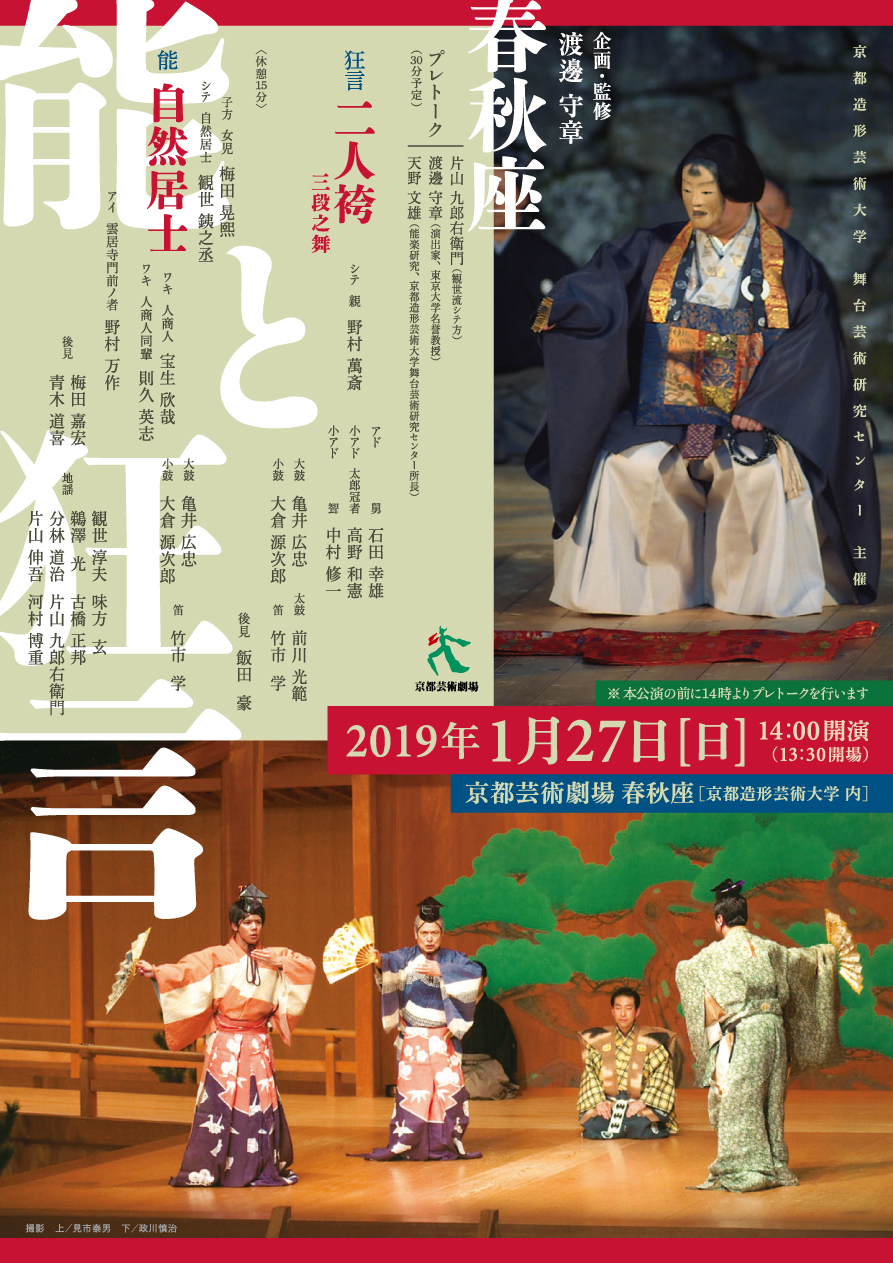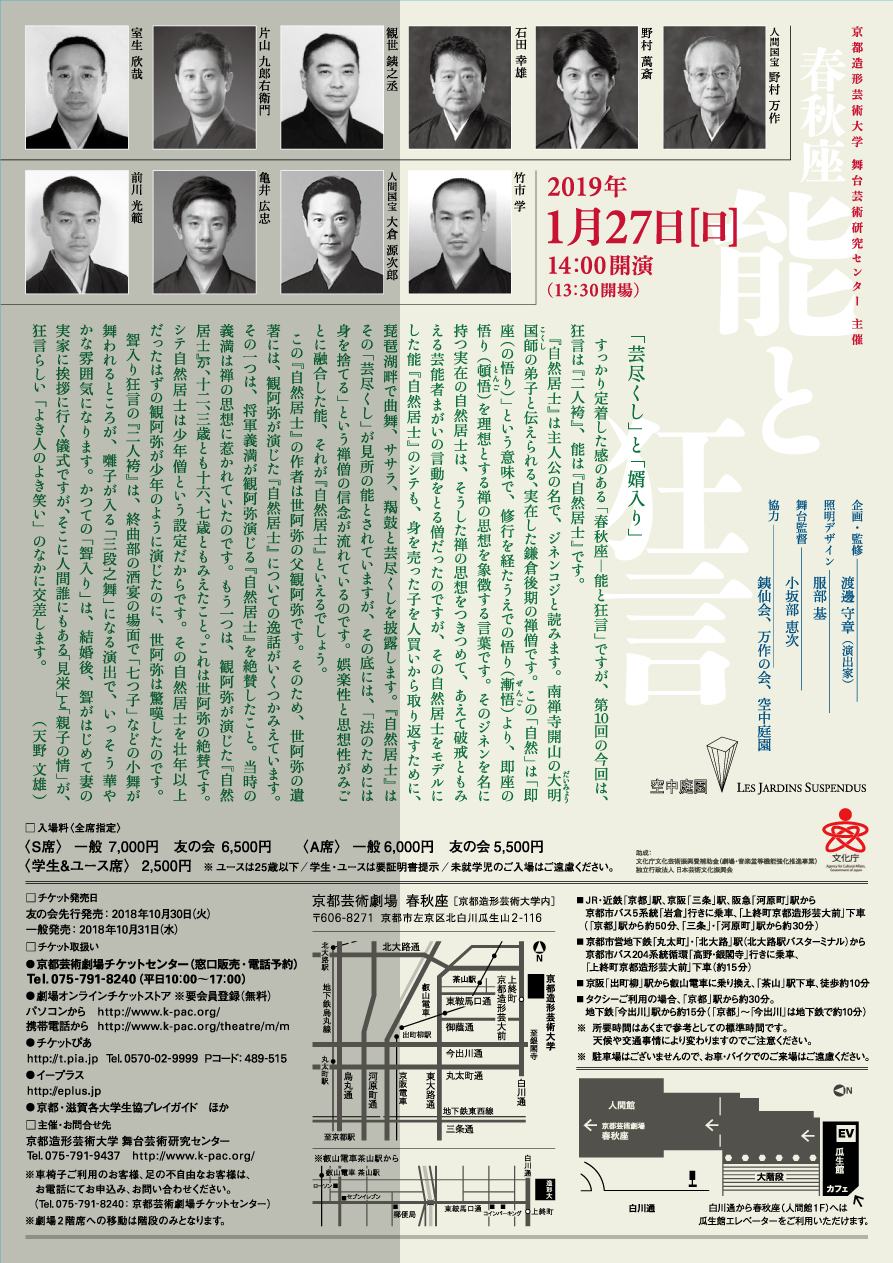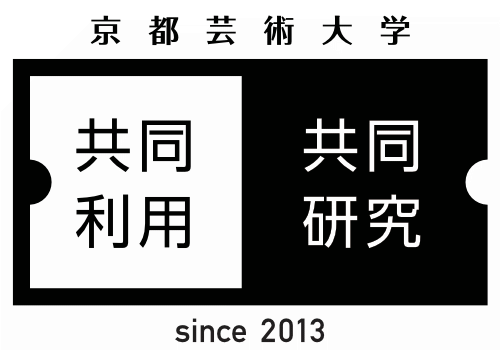公演詳細
主催公演
春秋座―能と狂言
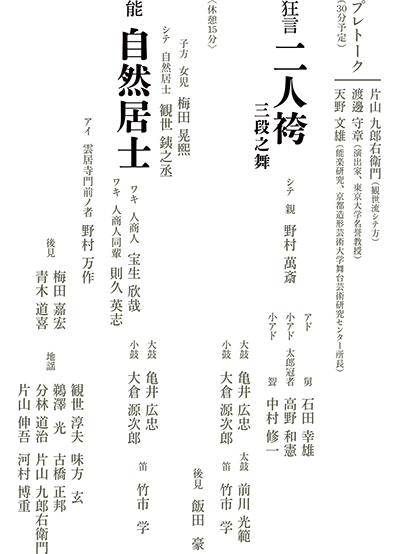
※画像をクリックすると拡大してご覧いただけます。
「自然居士」詞章 クリックすると拡大してご覧いただけます
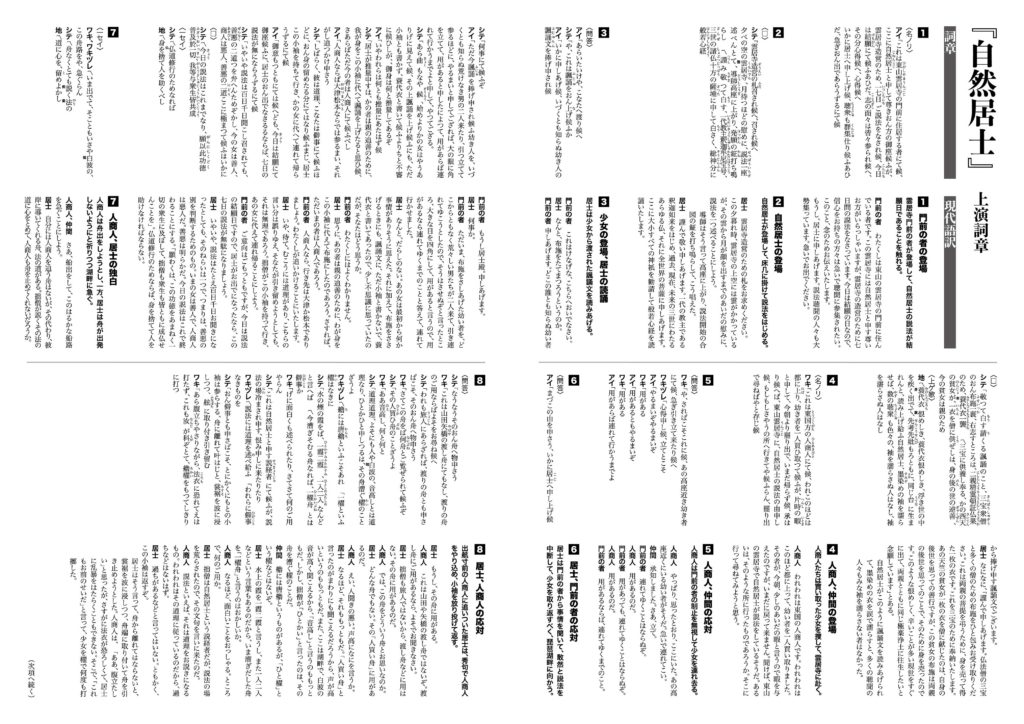
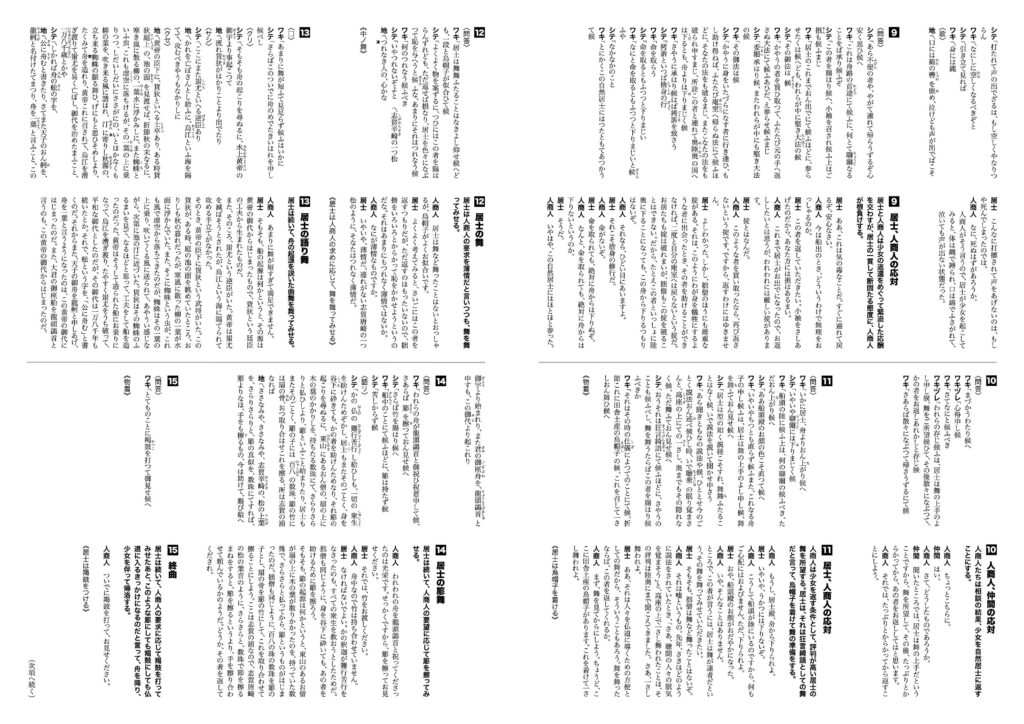
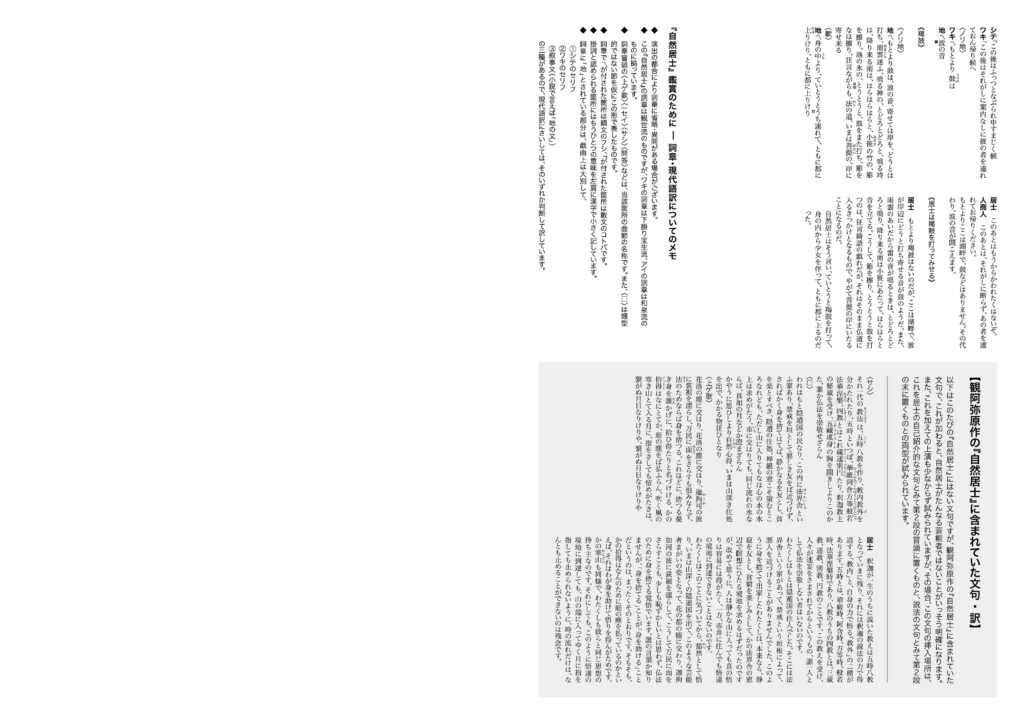
「芸尽くし」と「婿入り」
すっかり定着した感のある「春秋座―能と狂言」ですが、第10回の今回は、狂言は『二人袴』、能は『自然居士』です。
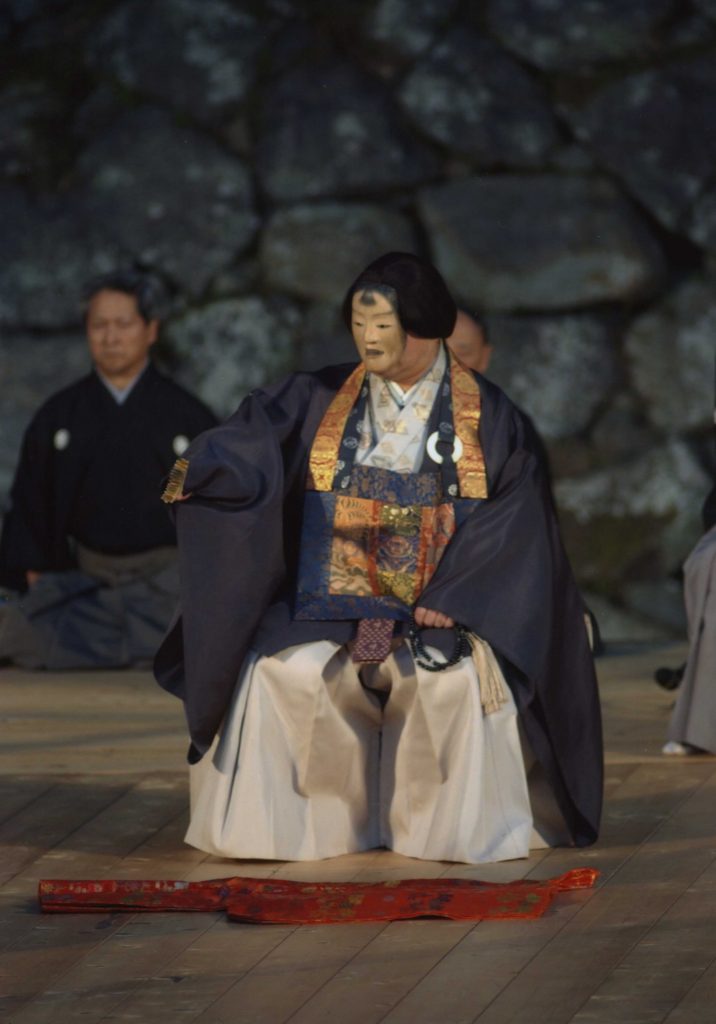 『自然居士』は主人公の名で、ジネンコジと読みます。南禅寺開山の大明(だいみょう)国師(こくし)の弟子と伝えられる、実在した鎌倉後期の禅僧です。この「自然」は「即座(の悟り)」という意味で、修行を経たうえでの悟り(漸(ぜん)悟(ご))より、即座の悟り(頓悟(とんご))を理想とする禅の思想を象徴する言葉です。そのジネンを名に持つ実在の自然居士は、そうした禅の思想をつきつめて、あえて破戒ともみえる芸能者まがいの言動をとる僧だったのですが、その自然居士をモデルにした能『自然居士』のシテも、身を売った子を人買いから取り返すために、琵琶湖畔で曲舞、ササラ、羯鼓と芸尽くしを披露します。『自然居士』はその「芸尽くし」が見所の能とされていますが、その底には、「法のためには身を捨てる」という禅僧の信念が流れているのです。娯楽性と思想性がみごとに融合した能、それが『自然居士』といえるでしょう。
『自然居士』は主人公の名で、ジネンコジと読みます。南禅寺開山の大明(だいみょう)国師(こくし)の弟子と伝えられる、実在した鎌倉後期の禅僧です。この「自然」は「即座(の悟り)」という意味で、修行を経たうえでの悟り(漸(ぜん)悟(ご))より、即座の悟り(頓悟(とんご))を理想とする禅の思想を象徴する言葉です。そのジネンを名に持つ実在の自然居士は、そうした禅の思想をつきつめて、あえて破戒ともみえる芸能者まがいの言動をとる僧だったのですが、その自然居士をモデルにした能『自然居士』のシテも、身を売った子を人買いから取り返すために、琵琶湖畔で曲舞、ササラ、羯鼓と芸尽くしを披露します。『自然居士』はその「芸尽くし」が見所の能とされていますが、その底には、「法のためには身を捨てる」という禅僧の信念が流れているのです。娯楽性と思想性がみごとに融合した能、それが『自然居士』といえるでしょう。この『自然居士』の作者は世阿弥の父観阿弥です。そのため、世阿弥の遺著には、観阿弥が演じた『自然居士』についての逸話がいくつかみえています。その一つは、将軍義満が観阿弥演じる『自然居士』を絶賛したこと。当時の義満は禅の思想に惹かれていたのです。もう一つは、観阿弥が演じた『自然居士』が、十二、三歳とも十六、七歳ともみえたこと。これは世阿弥の絶賛です。シテ自然居士は少年僧という設定だからです。その自然居士を壮年以上だったはずの観阿弥が少年のように演じたのに、世阿弥は驚嘆したのです。
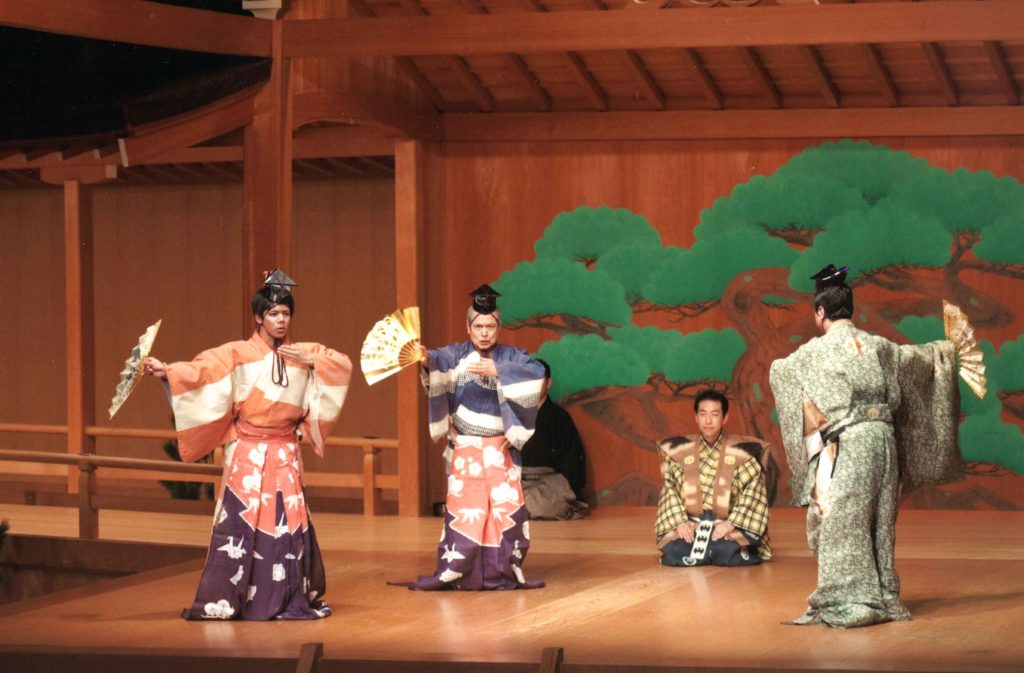
聟入り狂言の『二人袴』は、終曲部の酒宴の場面で「七つ子」などの小舞が舞われるところが、囃子が入る「三段之舞」になる演出で、いっそう華やかな雰囲気になります。かつての「聟入り」は、結婚後、聟がはじめて妻の実家に挨拶に行く儀式ですが、そこに人間誰にもある「見栄」と「親子の情」が、狂言らしい「よき人のよき笑い」のなかに交差します。(天野 文雄)
撮影:能『自然居士』見市泰男 狂言『二人袴』 政川慎治
公演情報
2019年1月27日(日)14:00
会場:春秋座
■
【企画監修】渡邊守章(演出家)
【照明デザイン】服部基
【舞台監督】小坂部恵次
【協力】銕仙会、万作の会、空中庭園
【企画監修】渡邊守章(演出家)
【照明デザイン】服部基
【舞台監督】小坂部恵次
【協力】銕仙会、万作の会、空中庭園
チケット情報
全席指定
一般発売 10月31日(水)10時
友の会先行発売 10月30日(火)10時
S席一般7000円 友の会6500円 完売
A席 一般6000円 友の会5500円
学生&ユース席 2500円
※学生・ユース席として、2階バルコニー席を取り扱っております。
一部舞台が見えづらいお席となりますが、ご希望の方はお電話もしくは窓口にてお申し込み下さい。
※未就学児童の入場はご遠慮下さい。

その他のプレイガイド



友の会先行発売 10月30日(火)10時
S席
A席 一般6000円 友の会5500円
学生&ユース席 2500円
※学生・ユース席として、2階バルコニー席を取り扱っております。
一部舞台が見えづらいお席となりますが、ご希望の方はお電話もしくは窓口にてお申し込み下さい。
※未就学児童の入場はご遠慮下さい。

その他のプレイガイド
English
Shunjuza Noh and Kyogen
27 January 2019, Sunday
Kyoto Art Theater Shunjuza
From 2 PM
Theater opens 1:30PM
This is a popular series of Shunjuza Theatre, which attempts to utilize the space and Hanamichi of kabuki theatre for classical Noh and Kyogen. By using a dynamic space different from the traditional Noh theatre, we can enjoy new theatrical creations.
Starring
Kanze Tetsunojo, Nomura Mansaku, and Nomura Mansai, and more.
Ticket Now on sale
Reserved seat
S seat: 7,000 yen sold out
A seat: 6,000 yen
U-25 and Students(Limited Seats) : 2,500 yen
・U-25 and Students have a valid ID required for purchase and to enter
・All seats reserved
・Please refrain from bringing reschoolers (age 5 & under)
Presented by Kyoto Performing Arts Center at Kyoto University of Art and Design
Supported by the Agency for Cultural Affairs, Government of Japan
<Plan, Supervisor> Moriaki Watanabe
Program
Noh have been performed since the 14th century. Many characters are masked, with men playing male and female roles. It is basically a dance form.
Kyogen has developed along Noh, and often played between intermissions of Noh play. However, it is not all similar to formal and symbolic Noh play. Kyogen is comical. It is basically phrases and singing.
・Pre-Performance Talk (Japanese only)
・Kyogen Futari Bakama Sandan-no-mai, or “Two in One Hakama with dances in three steps”
Futari Bakama is categorised as Muko-Iri Kyogen, which portrays the festive occasion of a groom visiting his wife’s house for the first time. This particular Kyogen includes small dances like Nanatsugo (“The Child of Seven”) in a banquet scene, performed in Sandan-no-mai style with music. This scene adds a colorful, merry atmosphere to the comedy, together with the “laughter of good natured people” caused by the humane “pride” and “parental affection” related to a groom’s ceremonial visit.
(Story-line)
A father decides to accompany his son to his in-law’s house’s gate, for the young groom is too bashful to make the visit by himself. He helps his son change into a long ceremonial hakama trousers and tells him to go into the house to meet his father-in-law alone. However, Tarokaja, the servant of the house, finds them, and the father is also invited in as a guest. The problem is that the father and son only have one pair of hakama for this formal occasion…
・Noh Jinen-Koji (“Jinen the Lay Monk”)
“Jinen-Koji” is the name of the Shite, or the main character of this Noh. He is a Zen monk in the 14th century and who was a disciple of Daimyou Kokushi, the founder of Nanzenji Temple in Kyoto. “Jinen-Koji”sometimes acted like an entertainer but his behavior (which seemed like that of a depraved monk) was rooted on his deep study of the philosophy of Zen Buddhism. The Shite of this Noh, modeled after this historical character, performs various dances called Kusemai, Sasara and Kakko around Lake Biwa in order to rescue a child from human traffickers. The Geitsukushi, an intense dance scene, is the highlight of Jinen-Koji. The scene, however, also shows the determination of the Zen monk to “sacrifice oneself for the Dharma”. Thus, we can say that Jinen-Koji is a good example of a Noh that successfully fuses entertainment and philosophy.
(Story-line)
“Jinen-Koji”, a young monk, was gathering people at Ungoji Temple in Kyoto to preach the holy teaching for seven days. On the last day, one orphan girl appears with a beautiful kimono. She asks Jinen-Koji to pray for the departed souls of her parents and donates the kimono as an offering. Jinen-Koji and the audience weep for her admirable conduct. However, the girl had sold herself to human traffickers in order to provide the kimono. The traffickers caught the girl and took her away. Jinen-Koji chased after them and arrived at the shore of Lake Biwa where the girl had been pushed into a boat. Jinen-Koji stopped the boat and got on board himself, telling the traffickers that he will accompany them if they do not release the girl. The traffickers threaten to kill him, but Jinen does not give in. Rather than take the risk of killing a Buddhist monk, the traffickers decide to humiliate him and tell him to dance. Jinen understands that the men are trying to vent their frustrations and dances various dances according to their requests. Thus, Jinen-Koji succeeds in having the girl released and returns to Kyoto with her.
Ticket
Box Office / Phone
Kyoto Art Theater Shunjuza
TEL 075-791-8240 (Mon-Fri 10:00-17:00)
Online * Pre-registration required
◆◆◆◆※credit card only (visa, mastercard)
◆◆◆◆◆Pick up tickets at local 7-Eleven convenience stores in Japan
Access
Kyoto Art Theater Shunjuza
Kyoto University of Arts and Design
2-116 Uryuyama, Kitashirakawa, Sakyo-ku, Kyoto 606-8271 Japan
From JR Kyoto station, Keihan Sanjo station, Hankyu Kawaramachi station
→Take bus #5 for Iwakura, get off at Kamihatecho Kyoto Zokei Geijyutsu Daigaku Mae (about 50 minutes from JR Kyoto)
From subway Marutamachi or Kitaoji station
→Take bus #204,get off at Kamihatecho Kyoto Zokei Geijyutsu Daigaku Mae (about 15 minutes from each station)
From Keihan Demachi Yanagi station
→Transfer to Eizan Densha line, get off at Chayama station. About 15 minutes-walk from Chayama.
→It takes 10 minutes by taxi to the University.
There is NO parking space for cars and motorcycles at the University.

